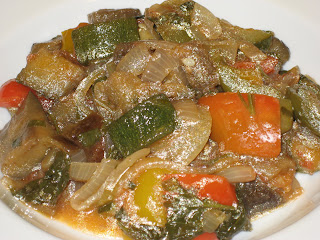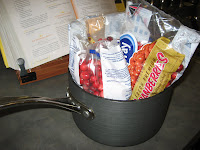
Happy Thanksgiving!
I'm going to take the next couple of recipes out of order so that I can tell you all about what I made for Thanksgiving. I still have a little backlog of recipes that I've cooked, but not blogged about yet. I'll get to those next week. But, now, I want to talk about
this recipe.
We spend Thanksgiving with my wife's family, which has now grown so big that we're a two-turkey family. The big dinner is at my sister-in-law's house. She was making the "big bird." I offered to make the smaller back-up bird at my house and bring it over. I've never cooked a turkey before, so I was pretty anxious and excited for the challenge.
The first step was to get the bird. The Book calls for a 12- to 14-pound kosher turkey. The blurb in The Book says that
Gourmet recommends kosher turkey because "it tends to surpass both supermarket brands and free-range birds in flavor as well as moistness." I don't have a ready source of kosher turkey, but there is
a turkey farm in my town, so I have a source of locally-produced fresh turkey. This is where the family has been getting our turkeys for years, so I wasn't going to break with tradition. On my sister-in-law's advice, I called about a month before Thanksgiving to reserve my turkey. I ordered a 16- to 19-pound fresh turkey, and the nice folks at Raymond's Turkey Farm told me that I could pick it up anytime the Monday to Wednesday before Thanksgiving.
So I decided to pick up my turkey on the Tuesday before thanksgiving, first thing in the morning before work, right when they opened at 8am. Easy-peasy, in and out, get the turkey throw it in the 'fridge at my house and back out the door and to work on time. Now, I've been to Raymond's many times, after all the place is an institution in my town. I've gone there to pick up a turkey pie, a roasted chicken, ground turkey, and other tasty things. But I'd never been there the week before Thanksgiving. Had I read
this article from the local newspaper, I wouldn't have been surprised when I got to the farm at 8:10 to find the parking lot full, two police officers directing traffic and a line out the door. Oh, and did I mention that it was raining? When I finally got out of the rain and into the farm shop, I was greeted by a woman presiding over a counter lined by about dozen card file boxes. "Name?" she asked. I told her, and she flipped through her card file, pulled out a card with my name and the size turkey I ordered written on it. I was taken aback a bit by the sudden realization that each card in the boxes represented a turkey. Later, I learned that the farm raises 20,000 turkeys each year, 9,000 of which are sold at Thanksgiving. Despite the long line, the farm runs a pretty efficient operation, and I was out the door, with my 17-pound turkey in hand, in about 15 minutes.


The day before Thanksgiving, I made the
Turkey Giblet Stock, which is a sub-recipe to the main roast turkey recipe, and is a component of the Giblet Gravy that accompanies the turkey. All of the turkey's innards were neatly wrapped in a tidy wax-paper package in the turkey's cavity. I identified the turkey's neck, kidneys, heart and liver, and browned them (except the liver) in a tablespoon of canola oil. Then, I added chopped celery, carrot, onion, a bay leaf and some peppercorns and thyme, along with some water and store-bought chicken broth (I'm all out of my own home-made stock, again!). Simmer for a bit less than an hour, cool completely and then refrigerate.
Then I made my pumpkin pie (I used The Book's
Basic Pastry Dough for the crust, but for the filling, I stuck with tradition and used the recipe from the back of the pumpkin can) and my cranberry sauce (check back tomorrow for that post), and went to bed to rest up for "the big show."
I woke up bright and early on Thanksgiving day. My goal was to get the turkey into the oven by 8am so that it would be done and we could be out the door and on the way to my sister-in-law's by noon.

First, I rinsed the turkey inside and out, and patted it dry with paper towels. Then I seasoned it with pepper and kosher salt (hey, even if my turkey wasn't kosher, at least my salt was). Then I tied the legs together and pinned the wings to the body with wooden skewers. Into the oven it went, first at a pretty high temperature, presumably to start to crisp up the skin and get the juices flowing. During this first half hour, there was an awful lot of crackling, sizzling and sputtering. After that, I reduced the oven temperature and began the roasting in earnest. I basted the turkey every twenty minutes, as directed by The Book.
Since this was my first attempt at roasting a turkey, and since I
still don't have
a decent instant-read thermometer, I opted to roast the turkey without stuffing it. I've heard so many horror stories about well-meaning amateur cooks poising their loved-ones with a stuffed turkey gone wrong. Also, the fact that I was going to be transporting my cooked turkey across town before serving it, made food safety a priority. I made the Herbed Bread Stuffing separately, and I'll blog about it tomorrow.
After about three hours, the turkey's thigh meat registered about 180 degrees. The Cook's Note in The Book says that an un-stuffed turkey would be done at 170 degrees. I was satisfied that I had enough of a margin of safety, even though I was a little bit worried that I might have overdone it a bit.
I took the turkey out of the oven and put the roasting rack on a tray so that the bird could rest for a bit. Meanwhile, I brought my turkey stock to a simmer on the stovetop. The Book says to "skim fat from pan juices and reserve 1/4 cup of fat." Well, there was about two cups of "pan juices" in the roasting pan, but no discernable "fat" to skim off ... it looked pretty homogeneous. I determined that it was pretty much
all fat, so I reserved 1/4 cup of it, and drained out almost all the rest, and hoped for the best. Then I put a cup of the stock in the roasting pan, put it over a burner and deglazed it, scraping up all those great browned bits on the bottom of the pan. All of that goes back into the rest of the simmering stock. Then I made a roux of the reserved 1/4 cup of fat and some flour. After a few minutes of whisking the roux over low heat, I added the broth and deglazing juices. After simmering and whisking for about ten minutes, I had a silky, rich and flavorful gravy.
After I made the gravy, the turkey was rested and ready. I put the turkey (on its rack) back into the deglazed roasting pan, wrapped the whole thing in foil, and put it into a large, newspaper lined cardboard box for the trip across town to my sister-in-law's house. After a short, but nerve-wracking ten minute drive, we arrived, and the turkey wasn't any worse for wear.
I was really happy with my first attempt at roasted turkey. It was pretty moist and flavorful with a beautiful, crispy, golden skin. I probably cooked it a little longer then I needed to, but I wasn't going to risk undercooking it, and I was still satisfied with the results. The aroma of the roasting turkey was great, and we have plenty of leftovers for sandwiches and some sort of turkey recipe or other.
Date Cooked: November 27, 2008
Degree of Difficulty: Easier than I thought it would be
Rating: A-
 We usually spend Christmas day with my wife's family. This year, my sister came up with the great idea of doing Christmas a little early with my side of the family. So, a little more than a week before Christmas, I had my grandparents and my sister and her family over for a holiday brunch.
We usually spend Christmas day with my wife's family. This year, my sister came up with the great idea of doing Christmas a little early with my side of the family. So, a little more than a week before Christmas, I had my grandparents and my sister and her family over for a holiday brunch.



















 Cute, cartoon rodents
Cute, cartoon rodents

























